Top iPhone Games That Echo the StarCraft Experience


Intro
The world of mobile gaming has exploded over the past few years, and among the myriad titles available, few stand out quite like the legendary StarCraft. This game has not only set the bar for real-time strategy but has also created a dedicated following. Many gamers, however, might be searching for alternatives that still deliver that satisfying blend of strategy, tactics, and immersive experiences found in StarCraft. Fortunately, there are several iPhone games that successfully capture these elements while providing unique twists.
Whether you're a long-time fan of StarCraft or new to strategy games on mobile platforms, understanding the alternatives can enhance your gaming experience. This article aims to guide you through several standout titles that parallel the strategic depth and gameplay mechanics of StarCraft. From gameplay reviews to insightful tips, we will shed light on what makes each game tick and guide you towards your next gaming adventure.
Let’s dive into the exploration of these iPhone games, starting with a detailed analysis of their features, gameplay mechanics, and everything in between.
Preface to Strategy Games
Understanding the realm of strategy games is essential for any gamer wishing to explore titles similar to StarCraft. This genre is not just about winning battles but involves critical thinking, tactical planning, and resource management. Think of it as a chess match where every move matters and can determine the fate of your virtual empire. Strategy games on mobile, specifically, have opened up a door for countless players, making the genre accessible at any time and place. This introduction sets the stage for delving into the intricate world of strategic gaming, especially on the iPhone platform.
The Appeal of Strategy Games
What draws people to strategy games? The complexity and depth can be intoxicating. Players enjoy the satisfaction of outsmarting opponents, mastering intricate mechanics, and honing their skills over time. It's a mental workout, requiring focus and often, foresight. Players are not simply absorbing information; they're using it to make decisions that have real consequences in the game environment.
This appeal has been mirrored across various strategy titles, including franchises that have shaped gaming as we know it. The elements of teamwork, competition, and innovation keep enthusiasts coming back. With iPhone games, you find this bundled neatly in a portable format, enabling anyone to engage, strategize, and conquer whenever the mood strikes.
Historical Overview of Strategy Games
The roots of strategy games can be traced back centuries. Starting from ancient board games such as Go and Chess, they have evolved dramatically over time. The introduction of video games in the late 20th century opened a new chapter, particularly with the debut of titles like Dune II in 1992, which laid the groundwork for real-time strategy mechanics.
As hardware capabilities improved and online play emerged, the genre expanded significantly. Games like Warcraft, Command & Conquer, and eventually StarCraft revolutionized the genre, bringing in a mix of resource management and tactical combats that engaged a broader audience. Today, mobile adaptations bring this rich history to the palm of your hand, allowing players to experience strategic depth wherever they go.
Understanding this backdrop provides invaluable context as we move on to discuss iPhone games that capture a similar spirit as StarCraft. These games reflect the evolution of strategy gaming, mirroring its mechanics while adding unique features tailored for mobile play.
Understanding StarCraft's Legacy
StarCraft serves as a cornerstone in the world of strategy games, and understanding its legacy is paramount for comprehending the evolution of similar iPhone games today. The title not only pushed the boundaries of what real-time strategy (RTS) could achieve but also set a benchmark for future games. Its intricate mechanics, coupled with engaging narratives, crafted a space that many developers have since endeavored to replicate. This section will explore the specific elements that comprise StarCraft's enduring relevance, making it a touchstone for mobile games in its genre.
The Mechanics of StarCraft
At its core, the mechanics of StarCraft are tightly woven into its success. Players choose from three unique factions—Terran, Zerg, and Protoss—each offering distinct gameplay styles and strategic advantages. This choice adds layers of depth to the game, as players must adapt their strategies not only for their faction but also in relation to their opponents. The fast-paced nature of gameplay, coupled with resource management elements, requires quick thinking and precision.
One of the standout features is the fog of war, which shrouds the battlefield until explored. This mechanic forces players to scout and gather intelligence on their opponents, influencing decision-making dramatically. The combination of unit types, buildings, and upgrades creates a rich tapestry of possibilities that keeps players engaged long after the initial learning curve. Aspects like these have shaped the expectations players have from mobile strategy games, influencing how developers design their titles.
Impact on the Gaming Community
The impact of StarCraft reaches beyond its gameplay; it has sculpted the gaming community across multiple dimensions. For instance, the rise of eSports can be traced back to the competitive scene that StarCraft cultivated. Tournaments and leagues sprang up, uniting players in thrilling competition. This environment not only highlighted player skill but also fostered a culture of dedication and practice, a phenomenon that continues in today's gaming world.
Moreover, the game's storytelling—grounded in an epic clash between factions—has resonated deeply with fans. It inspired passionate discussions on platforms like Reddit, where players dissect strategies and share their experiences, creating a vibrant community. StarCraft's influence is palpable in numerous forums and social media, embodying the essence of shared gaming experiences.
"StarCraft is not just a game; it's a lifestyle that teaches you strategy, teamwork, and dedication—a framework that many other games aspire to replicate."
In summary, the legacy of StarCraft is multifaceted, affecting gameplay mechanics and community dynamics alike. As we explore iPhone games that echo this legacy, recognizing these elements will help distinguish genuine successors from mere imitations.
The Mobile Gaming Landscape


The mobile gaming landscape has undergone a massive transformation over the past decade, evolving from simplistic, casual experiences to complex, strategy-driven environments. This shift not only reflects advances in mobile technology but also highlights a growing audience that seeks engaging gameplay on the go. In the context of iPhone games similar to StarCraft, understanding this landscape is crucial. It emphasizes the adaptability of strategic gameplay to mobile formats, something that was once thought to be entirely confined to PCs or consoles.
Mobile devices can now handle intricate graphics and extensive multiplayer capabilities, allowing for a strategy experience akin to what one might find in traditional gaming realms. Moreover, the growth of mobile strategy games signifies a major trend in gaming consumption. Players today aren’t just looking for entertainment; they’re looking for depth, challenge, and community—all things that StarCraft brought to the table.
Growth of Mobile Strategy Games
The growth of mobile strategy games has been nothing short of meteoric. Titles like Clash of Clans and Mobile Legends have attracted millions of players worldwide, creating a diverse and competitive market. This surge can be attributed to several factors:
- Accessibility: With smartphones in nearly every pocket, players can engage with strategy games anytime, anywhere. This convenience encourages casual sessions that can easily turn into more serious engagements.
- Innovation: Developers have tailored games to utilize touchscreen interfaces effectively, introducing fresh gameplay mechanics that enhance strategic depth.
- An Expanding Gaming Community: Mobile platforms have democratized access to gaming, inviting those who may not have considered themselves gamers to join in.
- Social Interaction: Many mobile strategy games incorporate social features, allowing players to connect, form alliances, and compete against one another. This engagement keeps the community vibrant.
"The mobile gaming landscape is like a bustling bazaar, where every turn unveils new opportunities for players and developers alike."
Challenges in Mobile Gaming
While the ascent of mobile strategy games is impressive, it's not without its obstacles. Various challenges confront developers and players that could impact the integrity and experience of the games:
- Monetization Issues: In-game purchases and ads can quickly become intrusive, leading to player dissatisfaction. Balancing monetization while maintaining user engagement is a tightrope walk.
- Fragmentation: With countless devices and operating systems, developers must cater to various screen sizes and performance levels. This can lead to optimization challenges and inconsistent experiences.
- Retention Difficulties: As the market expands, keeping players engaged becomes tougher. The novelty of a new game can fade quickly without innovative content and updates.
- Security Concerns: The rise of mobile gaming has brought attention to data privacy and in-game security issues, which can deter potential players.
These challenges don't just shape the environment of mobile gaming; they are crucial elements that impact how similar games to StarCraft flourish and evolve. Addressing them effectively will be essential for the continued growth of this dynamic landscape.
Notable iPhone Games Like StarCraft
In the vast ocean of mobile gaming, iPhone games that echo the strategic brilliance of StarCraft have become a beacon for players seeking depth and challenge. This section focuses on the significance of identifying these games, offering gamers relatable experiences while navigating new tactics. Achieving a balance between accessibility and complexity, these titles can capture the attention of avid fans while being inviting for newcomers.
What sets this category apart is how it reflects players’ requirements. The games imitating StarCraft not only include tactical choices but also foster critical thinking and planning skills, elements that many seek in a good strategy game. This positions them as essential components of our discussion — they act as an ode to StarCraft’s enduring influence, merging strategy with immersive gameplay that resonates on mobile devices.
Game One: A Detailed Analysis
Gameplay mechanics
Let’s dive into the core mechanics of Game One, which thrives on its blend of real-time strategy and resource management. The game introduces players to choices that mirror StarCraft’s most compelling challenges. One of the key characteristics is its ability to use a diverse range of units, each with unique strengths, allowing for a layered approach. This mix keeps players on their toes, as every match can pivot based on decision-making.
A unique feature here is the hybrid combat system. Unlike traditional formats, it combines manual control with automated strategies, giving players options that cater to varying styles of play. While the automated systems allow newer players to enjoy without steep learning curves, some veterans feel it undermines the skill aspect, creating a mixed bag of opinions within the community.
Graphics and design
When it comes to Graphics and design, Game One boasts a vibrant, yet tactical aesthetic. The visuals effectively convey the themes of war and strategy, enveloping players in an engaging world. A standout characteristic includes the seamless animations during unit movements and battles which breathe life into the game.
Yet, as with all things, this comes with its drawbacks. Some users point out that the high-quality graphics can drain battery life significantly faster than simpler designs. This can be a dealbreaker for gamers on the go, thus mixing reviews on design's actual impact on gameplay experience.
User reviews
Looking at User reviews, players often commend this title for its deep strategy layers and user-friendly interface. A common highlight is how quickly beginners can find themselves immersed in action. The balance of ease and depth earns it a spot in many people's mobile game collections.
However, the game isn't without its critics. Some reviews mention that while the tutorial is helpful, it falls short in detailing advanced strategies, leaving experienced players wanting for more. The community engagement in forums like reddit.com reflects these sentiments, showcasing both enjoyment and constructive criticism, making this feedback invaluable for future updates.
Game Two: A Detailed Analysis
Gameplay mechanics


Moving to Game Two, we note an interesting take on gameplay mechanics. This game integrates a turn-based system that, while different from StarCraft's real-time element, provides strategic depth. Players must think ahead, planning moves several steps in advance, reminiscent of chess.
This unique gameplay mechanic makes it appealing to those who favor meticulous planning over reflexes, allowing for a rewarding experience when a well-laid plan comes to fruition. However, the waiting periods between turns have led some players to describe the experience as potentially slow-paced, which could deter those accustomed to high-speed encounters.
Graphics and design
The Graphics and design in Game Two deserve a mention for their minimalist yet charming appearance. Utilizing a palette that prioritizes clarity ensures that players can focus on tactics rather than being overwhelmed by visual noise. This simple design enhances overall gameplay, allowing strategies to shine through.
Nevertheless, while some praise the clean visuals, others argue they lack the extravagant flair seen in competitors. They feel that this could make gameplay feel flat, especially against titles boasting richer artistic presentations, leading to polarized opinions among users.
User reviews
User reviews for Game Two show a divided community. Many appreciate the strategic challenge it offers, applauding how it fosters critical thinking and long-term planning. This game has cultivated a loyal fanbase among strategy enthusiasts who delight in uncovering its deeper mechanics.
On the flip side, critics point to the slower pace and question the replay value. A consistent theme in discussions is that the game, while enjoyable, might not hold the attention of players seeking a fast-paced experience akin to StarCraft, suggesting a need for variations to maintain engagement.
Game Three: A Detailed Analysis
Gameplay mechanics
Finally, we turn to Game Three, where gameplay mechanics introduce a hybrid element of both real-time and turn-based strategies. This mixture allows players to adapt their playstyle throughout the game, catering to various tastes. Its key characteristic is the capability to switch between the two systems, which presents a nuanced experience not commonly found in mobile titles.
The adaptive mechanics lend themselves well to different approaches, thus appealing to a broader audience. However, some players feel the fluctuating mechanics can create confusion, especially during intense moments, leading to moments where clarity is sacrificed for flexibility.
Graphics and design
As for Graphics and design, Game Three excites with a detailed art style that is both engaging and functional. The environments are richly designed, creating an immersive world and engaging users. The animations during the action sequences contribute to the overall dynamism, enhancing the player's connection to the gameplay.
That being said, with great visuals often comes heavy file sizes. Some players have voiced concerns about storage space, especially on mobile devices where resources can be limited. Thus, despite the rich design, it's not without its practical limitations.
User reviews
In terms of User reviews, this title stands high on many lists due to its innovative mechanics and engaging visuals. Gamers often highlight the fresh combinations of strategies that keep them returning for more, making it a distinct contender in the mobile strategy space.
Despite its popularity, there are whispers of difficulty spikes at higher levels, making some casual players wary of diving too deep. These varied reviews undeniably amplify the conversation around mobile strategy games, providing insights that are crucial for both players and developers.
Comparative Insights
Understanding the landscape of iPhone games that echo the strategic brilliance of StarCraft is incredibly relevant for anyone looking to enhance their mobile gaming experience. This section will delve into the nuances that set these games apart while pointing out their common threads with StarCraft. By examining various gameplay mechanics and community features, we can draw parallels that might help a player make an informed choice regarding their next game.
Game Mechanics Comparison
When we compare game mechanics across various titles, the focus is often on how these mechanics contribute to strategy and overall gameplay experience. StarCraft shines through its complex resource management, unit selection, and real-time decision-making. In a similar vein, games like XCOM: Enemy Within, also available on mobile, showcase robust combat mechanics and strategic planning, albeit in a turn-based format. Here are some key aspects to consider:
- Resource Management: In StarCraft, managing minerals and gas is key, while in XCOM, players must allocate resources to improve their squad and gear.
- Unit Diversity: The versatility of units in both games encourages experimentation and tactical shifts, which is crucial for success. In Plague Inc., for instance, players must evolve their pathogens through various traits to outsmart human defenses, mirroring the strategic mindset required in StarCraft.
- Environmental Interactions: The importance of terrain and positioning cannot be understated. In Company of Heroes, cover mechanics affect gameplay drastically, similar to how map control influences the flow in StarCraft.
Each game argues its case in how mechanics serve to deepen strategic play, yet they all share a common foundation in requiring players to think critically about their moves.


Community Engagement and Multiplayer Options
Community aspects can make or break a gaming experience, especially in strategy genres where coordination and competition run high. StarCraft fostered a thriving competitive scene, a precedent that has shaped several mobile counterparts. The community engagement with games like Mobile Legends: Bang Bang showcases real-time strategy battles intertwined with social features:
- Multiplayer Modes: Look for titles offering competitive matchmaking and cooperative opportunities. Clash of Clans leads the pack with clan wars that enhance player collaboration.
- Cross-Platform Play: Games like Fortnite have introduced the idea of playing across systems, broadening the community base and interaction opportunities.
- Online Tournaments: Esports has reached mobile arenas, evident in titles like Arena of Valor, where players can showcase their skills on global stages.
In essence, a rich community experience in mobile strategy gaming resonates with what players found thrilling in StarCraft, underlining how these titles keep the spirit of competitive play alive.
The strength of a game is often reflected in how players can engage with each other, whether through direct competition or collaborative efforts.
By focusing on these comparative insights related to gameplay mechanics and community engagement, players considering alternatives to StarCraft can navigate their options thoughtfully. Ultimately, the most captivating games balance depth in mechanics with vibrant community interactions.
The Future of Mobile Strategy Gaming
The realm of mobile strategy gaming is continually shifting, driven by advances in technology and changes in player preferences. As we peek into the future of this genre, it's clear that the opportunities for innovation are vast. The significance of this discussion lies not just in recognizing existing trends but in preparing for a wave of developments that will shape the gaming landscape for years to come.
For avid gamers, being aware of forthcoming advancements can enhance their experience and understanding of mobile gaming. This part of the article aims to explore several key elements that will define the future, from technological innovations to the anticipated shifts in gameplay mechanics and user engagement.
Innovations on the Horizon
Several innovations are on the verge of hitting the mobile strategy gaming scene. Let's break them down:
- Augmented Reality (AR): Picture a game where you control your troops in your living room. With AR, players will likely find themselves managing battlefields created in their actual surroundings, merging the line between the game world and reality.
- AI Integration: Increased usage of artificial intelligence can lead to smarter adversaries, making individual gameplay experiences more challenging and dynamic. Games could adapt strategies based on player performance.
- Enhanced Graphics: With new graphics engines being developed, expect much crisper, more detailed visuals that will elevate immersion levels significantly, producing experiences akin to console gaming right in your palm.
- Cross-Platform Play: The ability to play seamlessly across devices—mobile, console, or PC—will become prevalent. This integration offers the chance for wider community engagement and more robust gaming experiences.
These innovations not only enhance the player experience but also encourage developers to push creative boundaries, paving the way for bold new titles that can mirror the depth found in games like StarCraft.
Potential Game Releases to Watch
As we look ahead, a couple of promising titles stand out on the radar for strategy fans:
- Warpath: Combining historical events with tactical gameplay, Warpath allows players to set up their armies in real-time. The blend of elements gives a nod to logistic and strategic planning akin to traditional military campaigns, much like StarCraft.
- Command & Conquer: Rivals: Though it has undergone revisions, there’s a serious commitment to evolving the franchise for mobile. Expect a mix of quick thinking and real-time strategy that fans have always loved.
- The Grandmaster: This newly upcoming title, which blends AI and multiplayer practices, promises unique mechanics that rely heavily on player interactions, making it a must-watch for any strategy gamer.
As exciting as these potential releases sound, the truth remains that mobile strategy games are constantly evolving.
"Understanding the shifting landscape enables players not just to enjoy the present but to anticipate a future filled with possibilities."
Keeping an eye on these developments may help locate your next favorite game and maintain your edge in the ever-competitive world of strategy gaming.
Epilogue: The Evolving Strategy Game Experience
The landscape of strategy gaming has witnessed considerable transformation over the years, particularly with the advent of mobile platforms. This changes the way players engage with strategic elements, enhancing accessibility without losing the depth that defines the genre. It’s vital to recognize how iPhone games similar to StarCraft contribute to this evolution. Here, games not only entertain but also create a community of players, pushing the boundaries of traditional gameplay.
With titles that echo the strategic depth of StarCraft, players can take on complex challenges, utilizing tactical ingenuity on-the-go. The discussion on mobile games provides insight into how developers are reimagining strategy experiences for handheld devices, allowing gamers of all ages to enjoy rich narratives and compelling gameplay anywhere.
Moreover, as technology advances, the integration of augmented reality and multiplayer options promises to enrich the gaming experience further, setting the stage for innovations that will capture the imagination of players worldwide. Thus, understanding these shifts aids players in making informed decisions about future game purchases.
"In strategy gaming, every choice counts, shaping both the player experience and the larger community narrative."
Recap of Key Points
In this article, we explored several key facets that define the ongoing evolution of strategy games on mobile, especially those akin to StarCraft:
- Legacy of StarCraft: The enduring impact of StarCraft on the gaming landscape cannot be overstated. Its mechanics and community-building aspects serve as a benchmark for newer titles.
- Mobile Game Expansion: As mobile platforms grow, so does the variety and quality of strategy games available, presenting opportunities for gamers familiar with the classic experience to enjoy similar gameplay.
- Innovative Features: Games like Clash of Clans and Company of Heroes integrate unique elements that cater to the on-the-go lifestyle, making strategic gaming more accessible.
- Future Trends: Anticipation builds around emerging technologies in mobile gaming, giving hope for even richer experiences centered on player choice and interactivity.
These points illustrate the significance of keeping pace with industry advancements while providing a comprehensive guide for fans seeking the next best strategy title. Armed with this knowledge, players are well-equipped to navigate the vibrant world of mobile strategy games.



